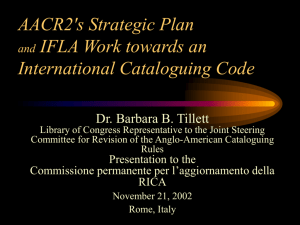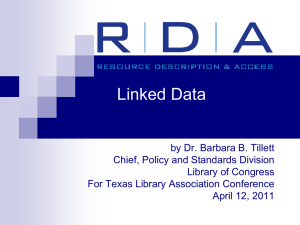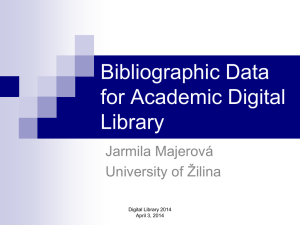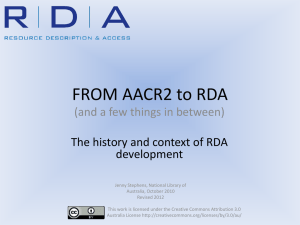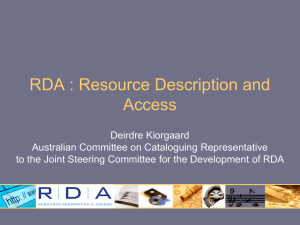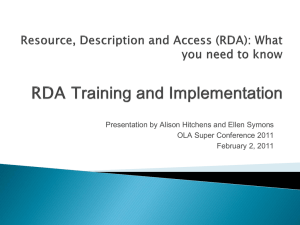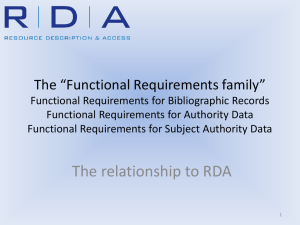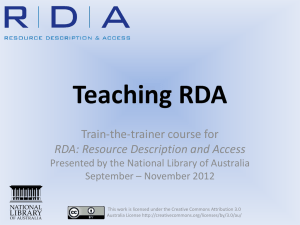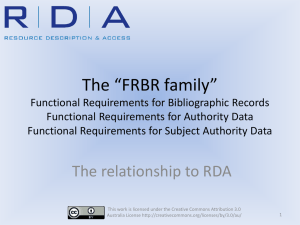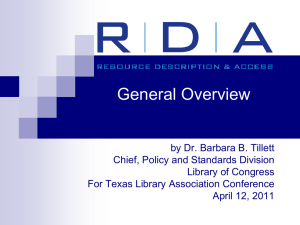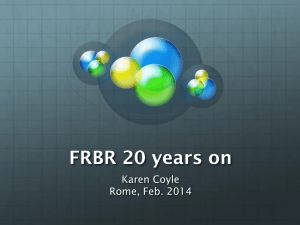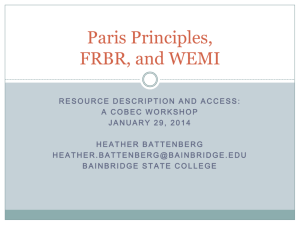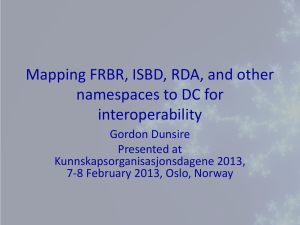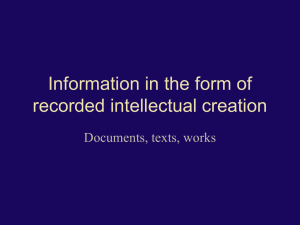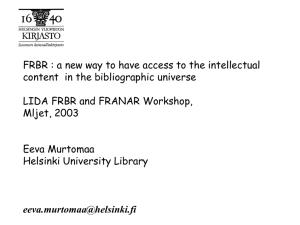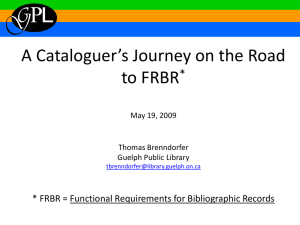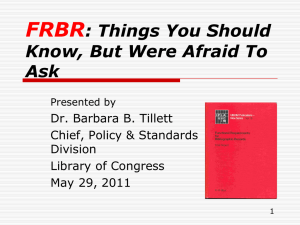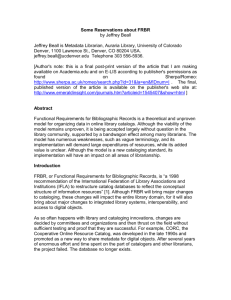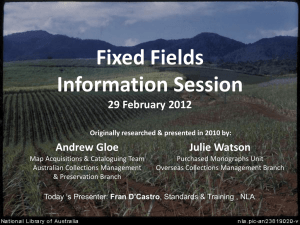P2 - Providing Context for RDA
advertisement
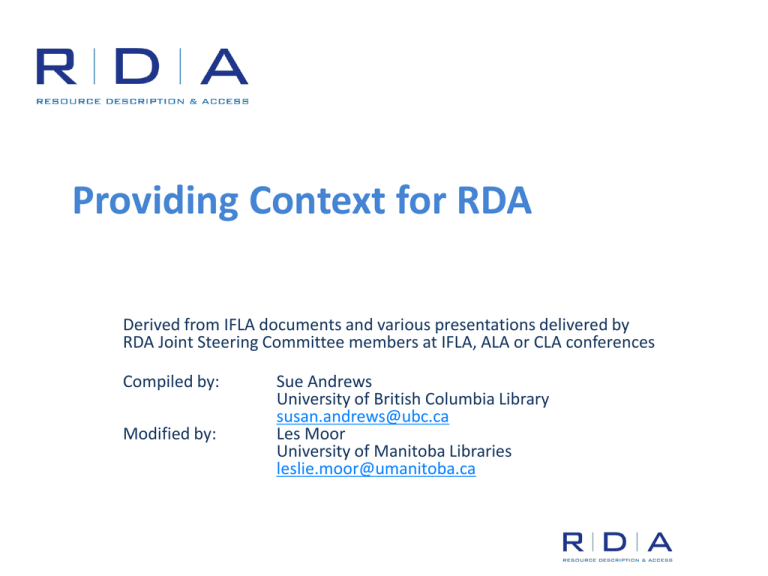
Providing Context for RDA Derived from IFLA documents and various presentations delivered by RDA Joint Steering Committee members at IFLA, ALA or CLA conferences Compiled by: Modified by: Sue Andrews University of British Columbia Library susan.andrews@ubc.ca Les Moor University of Manitoba Libraries leslie.moor@umanitoba.ca Re-Use of Materials This work is licensed under the Creative Commons Attribution-NonCommercialShareAlike 2.5 Canada License. To view a copy of this license, visit http://creativecommons.org/licenses/by-ncsa/2.5/ca/ or send a letter to Creative Commons, 444 Castro Street, Suite 900, Mountain View, California, 94041, USA. Objectives of this module • Identify major developments in cataloguing that have influenced RDA • Introduce the Functional Requirements for Bibliographic Records • Understand the origins of the organization and terminology of RDA • Understand RDA’s role in an international cataloguing context RDA Influences • Major events and studies influencing RDA – Paris Principles (1961) – AACR (1967); AACR2 (1978) – Stockholm Seminar (1990) – FRBR (1998) – FRAD (2004) – IME/ICC (2009) • RDA (2010) Paris Principles (1961) • Originated from “The International Conference on Cataloguing Principles” – Paris, 1961 • Influenced by > 100 years of previous codes and principles • Highly influential AACR (1967) AACR2 (1978) • Originated from “The International Conference on Cataloguing Principles” – Paris, 1961 • Influenced by > 100 years of previous codes and principles • Highly influential Stockholm Seminar on Cataloguing (1990) • IFLA-sponsored seminar with participants from around the world • Agreement on the need for a re-examination of existing international cataloguing practices • Proposed an IFLA-sponsored study to: • Examine the relationships between the data elements in bibliographic records and the user needs to be met. • Recommend an internationally acceptable basic level of functionality and a set of basic data requirements for records created by national bibliographic agencies. • i.e. what do we really need in our records? The findings were reported in the (1998) IFLA publication: Functional Requirements for Bibliographic Records Functional Requirements for Bibliographic Records (FRBR) (1998) • A user-based approach • No a priori assumptions • An entity analysis technique – entities – attributes – relationships • Consideration of all users, all formats • Independence from any particular cataloguing code FRBR: Generic User Tasks • To find (e.g. materials on a given topic, by a given author). • To identify (e.g. confirm that the record retrieved corresponds to the document or format sought, and to distinguish between two resources with the same title) • To select (e.g. have enough information to decide which of multiple records best suits the user’s needs) • To obtain (e.g. have enough info to find on shelf, order, access electronically, the resource you’ve discovered) FRBR Entities 1 Works Expressions Manifestations Items 2 Persons Families Corporate bodies 3 Concepts Objects Events Places Relationships between Group 1 Entities The Movie The Novel Work: Expression: Orig. Text Transl. Critical Edition Manifestation: Paper Item: Copy 1 Autographed PDF Copy 2 HTML Orig. Version FRBR Relationships • Persons, events, other works – are the subjects of Works • Authors, artists, composers – create Works • Editors, translators – realize Expressions • Publishers, printers – publish or print Manifestations • Donors, libraries – own Items FRBR in MARC Work - red Expression - blue Manifestation - green Item - orange Functional Requirements for Authority Data (FRAD) (2009) What are the functions of Authority Data? – To Document decisions – To Serve as reference tool – To Control forms of access points – To Support access to the bibliographic file – To Link bibliographic and authority files FRAD User Tasks and Entities User tasks: – Find (e.g. information on an entity and its associated resources) – Identify (e.g. confirm that the entity described corresponds to the entity sought) – Contextualize (rda: clarify) (e.g. clarify the relationship between two or more entities) – Justify (rda: understand) (e.g. understand why a particular name or title is chosen as the “preferred” name or title) • Entities: – FRBR Group 1 (work, expression, manifestation, item) – FRBR Group 2 (person, family, corporate body) – FRBR Group 3 (concepts, objects, events, places) FRAD basic relationships IME-ICC General principles (2009) General principles: 1. Convenience of the user. 2. Common usage. 3. Representation. 4. Accuracy. 5. Sufficiency and necessity. 6. Significance. 7. Economy. 8. Consistency and standardization 9. Integration. “The rules in a cataloguing code should be defensible and not arbitrary. It is recognized that these principles may contradict each other in specific situations and a defensible, practical solution should be taken.” See http://www.ifla.org/files/assets/cataloguing/icp/icp_2009-en.pdf RDA (2010) • Scope: support of basic user tasks from FRBR (FISO) and FRAD (FICJ) • Principles: guided by IME-ICC: – Differentiation, sufficiency, relationships, representation, accuracy, attributions, language preference, common usage or practice, uniformity • Core Elements: – Guided by FRBR/FRAD “high value” elements to support user tasks, ISBD mandatory elements Summary AACR2 Paris Principles Stockholm Seminar FRBR/FRAD IME/ICC ETC. • RDA is a convergence of a number of cataloguing codes, principles, and initiatives Questions

